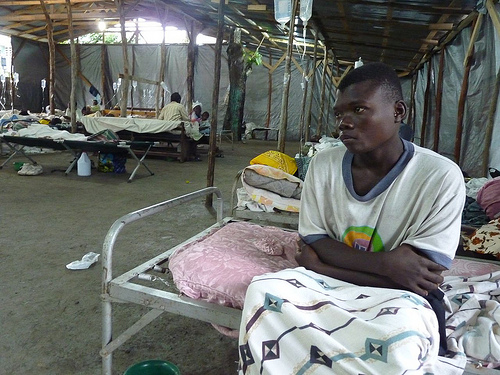
In “Alms Dealers,” which exposes the potential of humanitarian aid to cater conflict, Philip Gourevitch asks, “Does the modern humanitarian-aid industry help create the kind of misery it is supposed to redress?” (2010:105) When reflecting on the media’s coverage of the ongoing cholera epidemic in Haiti, we must similarly consider whether the end result is straight reportage, altruism, or something more unseemly. I argue that while the media is not overtly complicit in the conditions that have fomented the crisis, their steady supply of a barrage of images of human suffering in overwhelming proportion to explorations of the underlying causes—as has been the approach of several television news outlets—has the effect of relegating Haitians to the role of the noble savage, there to exact the viewer’s catharsis by stirring emotion for emotion’s sake.
In an article for the Columbia Journalism Review, Maura R. O’Connor discusses the cholera epidemic’s starring role in “disaster porn,” which she describes as the television news media’s (in particular CNN’s) reliance on a “B-roll of tragedy and disaster” that is intended to draw in an audience, but “without a moral component of responsibility towards Haitians themselves over the long-term” (2010). Gourevitch remarks on the precedent set by the televised coverage of the Biafra crisis that “the graphic suffering of innocents made an inescapable appeal to conscience” (2010:102). Certainly the vivid images spurred some of the billions of dollars in donations to international agencies such as the Red Cross, World Vision, and Oxfam (Hildebrandt 2011). But after continued exposure to these images, we are no closer to understanding Haiti’s underlying infrastructural problems and their government’s own agency in managing the epidemic.

In this video from CNN, we see the same eight images of suffering on a loop as the anchor conducts her interview with a U.N. representative. The clip resonates with the words of Linda Polman, whose book describing how “reporters are exploited by aid agencies […] to present stories of suffering without political or historical context” is cited in Gourevitch’s article (2004:107). The images fulfill the medium’s practical need for visuals, but their repetition begins to feel gratuitous and as a viewer, I question whether the building sense of helplessness it engenders is meant to excuse the lack of a more probing explanation—as if to say, “We’re sorry we couldn’t do better, but if you feel terrible, maybe you won’t notice.”
That’s a cynical outlook, to be sure. And of course, the visual medium of television does not readily lend itself to conveying the complexity of such issues. Television’s strength is in its ability to let the images speak for themselves; however, the voices of the people depicted are needed to add dimension. An account by American-born journalist Ansel Herz details how, in the wake of the earthquake, he was approached for an interview by the CBC. Herz offered to put the crew in contact with an English-speaking Haitian professional instead, but the producer insisted on Herz, stating that they were only “comfortable” with him. (Herz used the opportunity to remark, on camera, about the absurdity of journalists interviewing journalists.) As a result, an opportunity to depict Haitian agency was lost.
Print media offers the chance for more in-depth analysis and greater reflexivity, though it is not immune to accusations of sensationalism. Though there are many balanced examinations of the political affairs in Haiti, such as this piece from The Montreal Gazette that investigates the failure of the country’s civil service, there also exist accounts such as this one from Newsweek, which essentializes the Haitians as a “resilient people” from the perspective of a frightened reporter who observes the scene from inside his SUV. Vancouver-based journalist Crawford Kilian, who has written extensively on the cholera epidemic for The Tyee and own his own public health blog, responded to O’Connor’s questioning of the line between unflinching depictions of human suffering and “disaster porn” as follows:
In most cases, I leave it to your intelligence and perception to distinguish between information and porn, though sometimes I have to editorialize (and moralize) about what I’m posting. Again, I leave my views to your judgment.
And to moralize about disaster porn, I think we all need to reflect carefully on why disasters like Haiti engage us, and about our own responses. (Kilian)
When it comes to neutrality, I believe this level of self-reflexivity should be the standard of all media outlets. Speaking of humanitarian aid, Gourevitch observes that “impartiality in the face of atrocity can be indistinguishable from complicity” (2010:107). In the case of the cholera epidemic, I would characterize a subsection of the media—and in particular television media—as catering to voyeurism rather than conflict. I would not go so far as to suggest that voyeurism is the equivalent to complicity, but that it does little to disseminate a more grounded, contextualized understanding of an area of the world many of us know little about.
Works Cited
Bruemmer, Rene
2010 Haiti Civil Service in Ruins. The Gazette, Oct. 23. http://www.montrealgazette.com/news/Haiti+civil+service+ruins/3714823/story.html, accessed Jan. 9, 2011.
CNN
2010 Sick desperate to get help as Haiti cholera outbreak kills 138 [Video] https://www.youtube.com/watch?v=1C7v4cAcAZQ, accessed Jan. 9, 2011.
Gourevitch, Philip
2010 Alms Dealers. New Yorker, Oct. 11: 102–109.
Herz, Ansel
2011 Yesterday Afternoon, For Whatever It’s Worth. Mediahacker, Jan. 13. http://www.mediahacker.org/2011/01/yesterday, accessed Jan. 15, 2011.
Hildebrandt, Amber
2011 Donations to Haiti 1 Year After Quake. CBC News, Jan. 5. http://www.cbc.ca/canada/story/2011/01/05/f-haiti-earthquake-anniversary-aid-agencies.html, accessed Jan. 9, 2011.
Kilian, Crawford
2010 Haiti Coverage as Disaster Porn. H5N1 Blog, Nov. 19. http://crofsblogs.typepad.com/h5n1/2010/11/haiti-coverage-as-disaster- porn.html, accessed Jan. 15, 2011.
O’Connor, Maura R.
2010 Haiti Coverage and “Disaster Porn.” Columbia Journalism Review, Nov. 19. http://www.cjr.org/behind_the_news/haiti_coverage_and_disaster_po.php, accessed Jan. 9, 2011.
Tuttle, Steve
2010 Haiti in the Time of Cholera. Newsweek, Nov. 11. http://www.newsweek.com/2010/11/11/haiti-in-the-time-of-cholera.html, accessed Jan. 15, 2011.